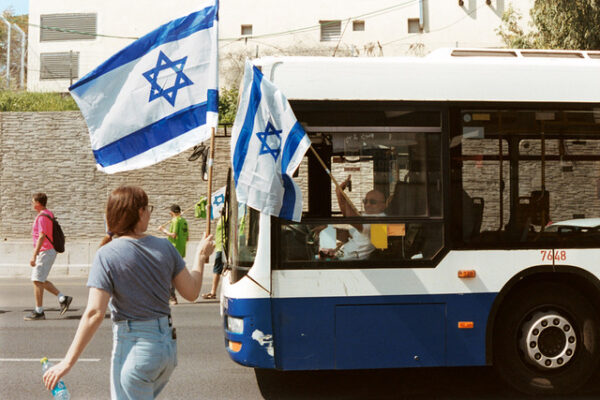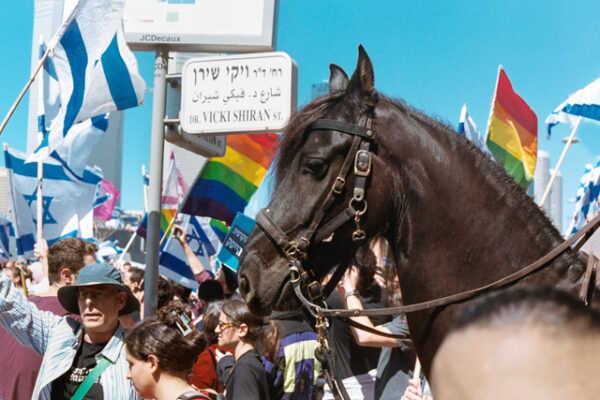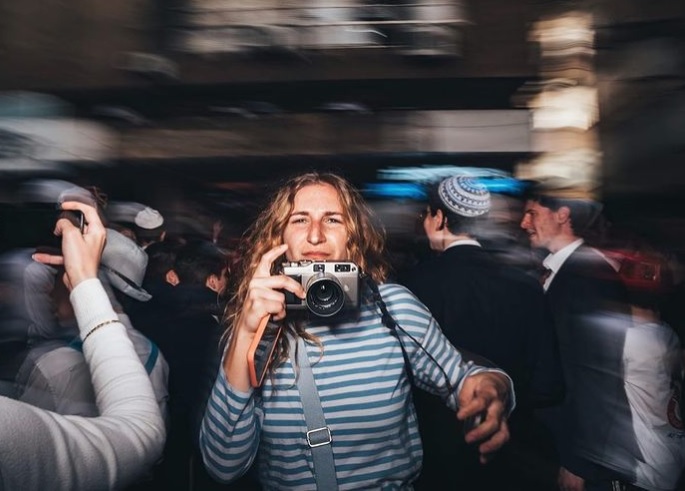Part of our work at Art Source involves keeping an eye on the careers of emerging artists before they break through. Photographer Alex Farfuri piqued our interest a few years ago and we were fascinated by the recent shift in her work – for anyone following the protest movement in Israel, her images have become a daily presence in our lives, seemingly out of nowhere. I sat down with Farfuri to discuss how her artistic practice shapes her photojournalism work.
Five years ago Farfuri made the decision to leave her visual communication studies at Holon Institute of Technology with the dream of someday becoming a photojournalist. Today she is one of the leading photographers documenting the protest movement. Among the slew of footage in the press, Farfuri’s documentation on her Instagram has been providing a refreshing point of view – weaving intense, at times painful moments of political and even historical magnitude, with hopeful, touching human moments, balancing artistic and journalistic photography.
When she was a student Farfuri says she was compelled to jump into documenting the streets and didn’t want to wait. “I felt like it was calling me. I didn’t know anybody that was doing street photography or even calling what I was doing street photography. I wanted to believe in it so I just declared it.”
Farfuri went to where she felt most in her element, the place that would become the backdrop of her most iconic images for the next few years – the beach. She spent days on end studying beach goers in Tel Aviv, their behaviors and motivations, and documenting them. “I felt like at the beach people were acting much more free and loose and I loved that. The most human you can be is at the beach.”
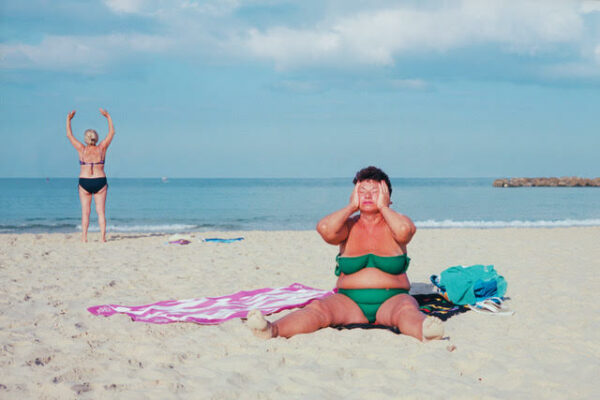
Farfuri says she went about “archiving her surroundings” – the beach, the city streets, images that differ from the ones she feels are most representative of what people perceive Israel to look like. “When you google Israel the results are very much about war and conflict, shown from a male perspective and it didn’t match how I felt living here”.
In her photographs from this period Farfuri highlighted everyday moments – minor human interactions, cultural juxtapositions that can only come to be in Tel Aviv – these images make the mundane shine and give us a glimpse into what she sees as beautiful, moments that many of us may overlook in our day to day. Bringing this perspective into her photojournalism work is part of what makes her footage stand out.
She says she focused on showing the story “in a joyful, quirky way, not what is considered traditional beauty but what I feel is beautiful. I always challenged other people to see the way I see”.
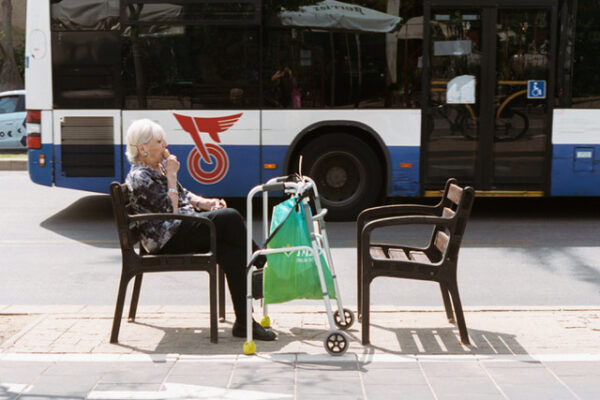
I asked Farfuri about the major change in her subject matter – from the serene beach to the dramatic protests.
“I always loved going to protest, capturing the waves of emotion and passion around me.” She says it was always important to her to show solidarity with previous protest movements, but now it’s different – “it’s my personal fight this time”.
She left her still camera at home and devoted herself fully to video, “I felt it was so important to show video this time, it gives you a deeper effect of what happened and makes it more real. Using Instagram stories as a tool is no different to me than opening a newspaper that’s relevant for 24 hours.”
Farfuri’s own passion and emotion bursts out of every frame of her documentation of the protests and she is unwavering in her dedication to communicate both harsh truths about the challenges we face, as well as the beauty she captures in intimate moments as she sees it, just like she has from her early days at the beach.
“I look for small moments that tell the big scenario”. As important as it is to show the masses that are mobilized to protest in images taken from a drone, Farfuri is more interested in the intimate interactions that we won’t see on the news. “I rather catch a mother explaining to her daughter about the importance of going out and protesting. I like touching people’s emotions”.
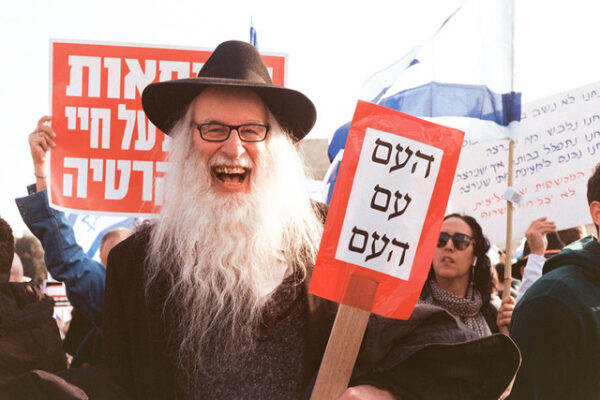
“I love people, I’m fascinated and inspired by the people around me and I’ve never been afraid of anyone”. This is evident in her coverage of the protests, always front and center, and also in her willingness to document protestors with very opposing views to her own, with the same dedication and empathy, even though at times this could potentially put her in harm’s way.
She started feeling a shift in that core attribute. “The protests made me really scared of cops. That’s why I’m very obsessed with cops, I always film them, trying to understand their intentions”. This comes through in the stories she shares on Instagram. One example is her documentation of the horses that have become a fixture in the police response to the protests. Farfuri can show us the terrifying use of animals as weapons and then an intimate moment of affection between a police officer and a police horse.
She recalls a protest she filmed on March 1st, “It was really scary, it felt like wherever you went there were stun grenades coming at you and it was unbelievable that they (the police) could act that way. It made you feel like you were very much against the cops and they were not on your side. Then there was a moment that I captured. I was photographing this young female magavnikit (border police, many of which serve as part of their mandatory military service at age 18 – MF) and she lost it. She was trying to attack protestors, police were holding her back and her friend was doing all she could to calm her down, hugging her.” Farfuri says this dynamic reminded her of the vulnerability of the people on opposite sides of the protests “I could also lose it. She’s only 18. I found myself in between them in a time I’m supposed to fear them and I found so much compassion towards them. I learned a lot from that – I always remember that moment when I see the cops around me – we’re all human.”
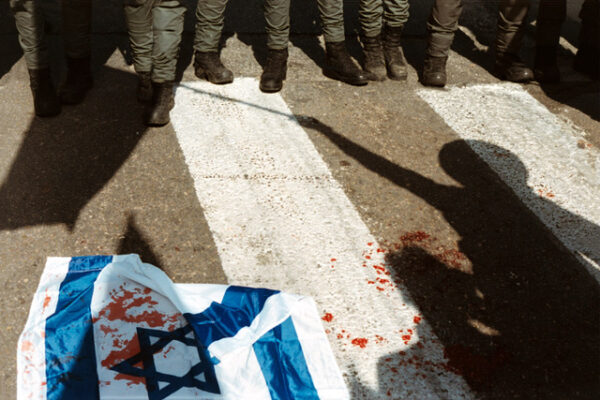
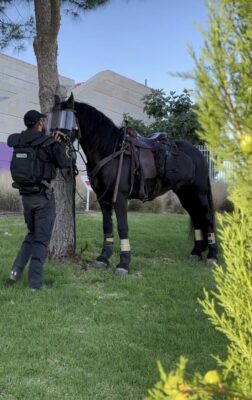
When it comes to her documentation of police violence against protesters and members of the press, including herself, Furfuri days she dissociates. “I don’t really feel it at the moment. I become like the camera, I’m documenting now and I’m not feeling what I’m seeing”. Later, when she goes over her footage it hits her. “It horrifies me. It’s the closest to war I’ve ever been, it’s like a battlefield five minutes from my house. It’s crazy”.
“Israel is such a small country and I’m always getting messages from people recognizing people they know. I’ve also had instances where it got violent and parents saw their son getting beat up by police, live on my stories. It’s weird to be that messenger.”
As hard as it is, Farfuri knows that this documentation is important. Thanks to social media sleuths using her images to identify both the victims and the attackers, her videos have been used as proof in investigations of police brutality. “How amazing would it be to go on the streets and every cop would be scared to be in front of the camera or want to act their best because they know they don’t want to look like that on social media”.
Farfuri has been closely following the way the current government’s rhetoric and limitations on the rights of women and minorities are impacting the mood in the streets both in and outside of the Tel Aviv bubble. She’s shining a spotlight on the vandalized images of women on billboards for example – literally deleting women’s presence from the public sphere.
She traveled to the religious city of Beit Shemesh to give her followers an insider’s view of what life there can be like for women – something we don’t often get to see on social media. Farfuri covered the segregation between men and women in the city, where women are expected to use separate sidewalks and buses and adhere to a very strict dress code – she describes it as her idea of hell.
According to Farfuri she used to have to leave Tel Aviv to document this kind treatment of women “but now it’s here. It’s like a disease that’s spreading” (Farfuri is referring to growing accounts in recent months of bus drivers illegally demanding women and girls sit on the back of the bus or not board in what they deem as revealing clothing – MF).
Farfuri, now 30, moved to Israel from New York at the age of 8. We talked about the duality that we both experience as American-Israelis with roots in NY. “I’ve always felt like a foreigner here” Farfuri says, at the same time, she very much sees herself in the locals in Tel Aviv, which is one of the reasons she feels so compelled to photograph them.
I ask her the question so many of us are grappling with on a daily basis – will you stay?
“I think every Israeli is going through this and talking about it. I want to stay 100%, that’s why I’m fighting. I’m inspired by Israel and I want to live here. But if I’m going to be told how to dress, where to walk, what bus to go on, which beach to go to at what hours – I can’t, that’s my biggest fear.”
While Alex aspired to become a photojournalist since early on in her career, she certainly wasn’t expecting the timeline to unfold the way that it has. “I’ve always dreamed of being a photojournalist. That’s where photos make an impact and can change the conversation and I’ve always wanted to be in that place. I just didn’t know I would become a photojournalist this year”.
Her documentation of the protests was her most organic reaction to her environment. Her almost cinematic coverage of them became an opportunity for her to make an impact and to carve out space for her unique point of view to become an important part of the conversation for her ever growing audience (currently over 55K following on Instagram). She gives the viewers a chance to experience the essence of what it can be like to live in Israel – the harsh brutal aspects, tightly interwoven with beauty and solidarity.
